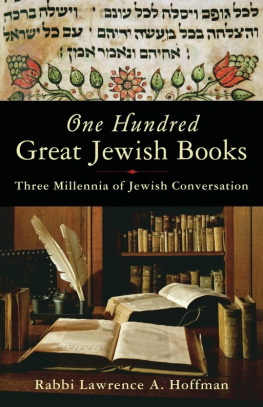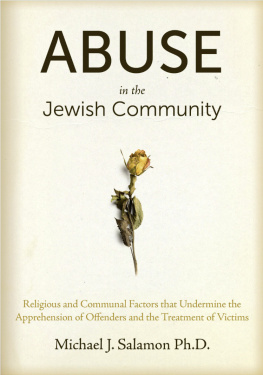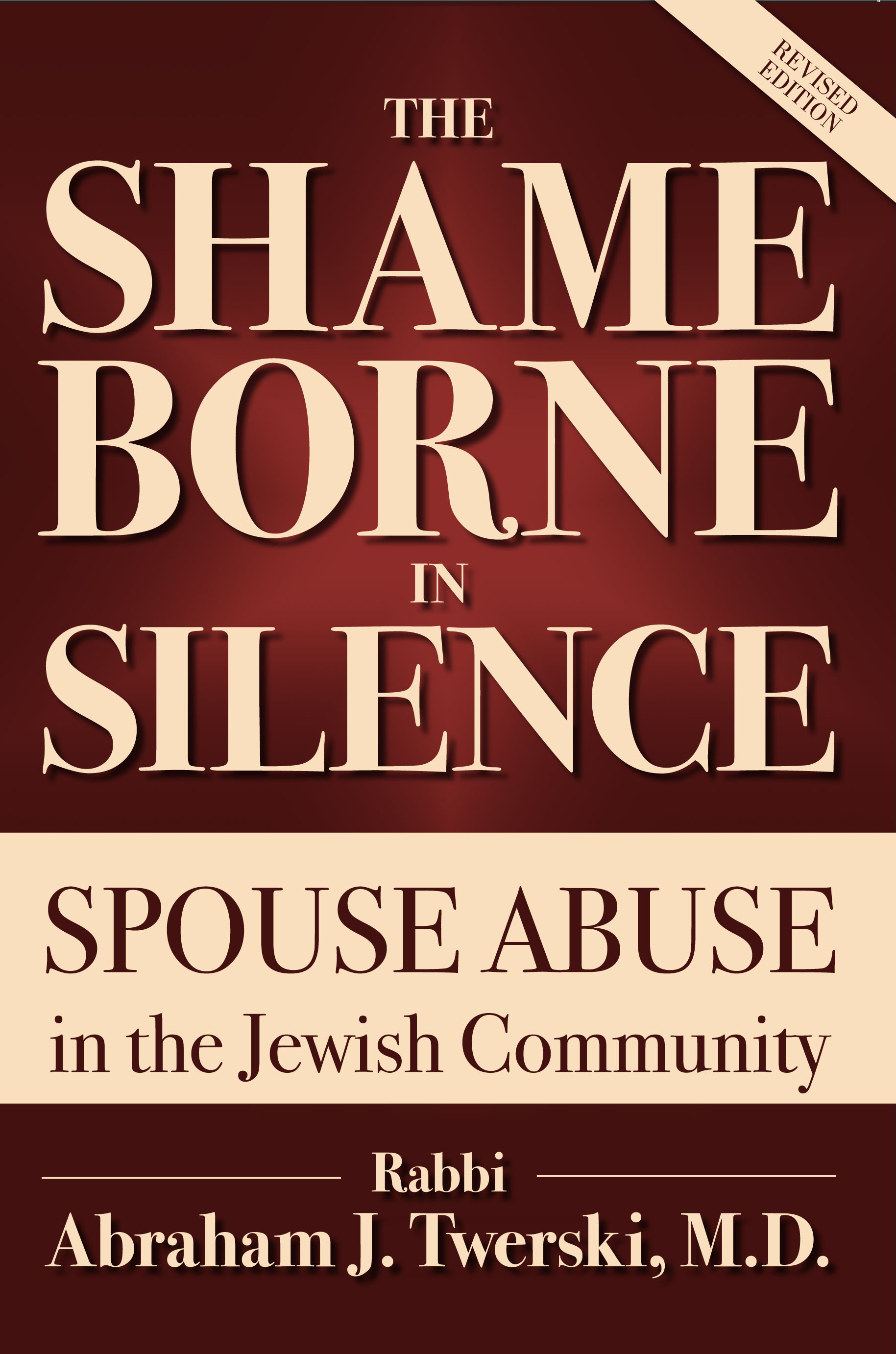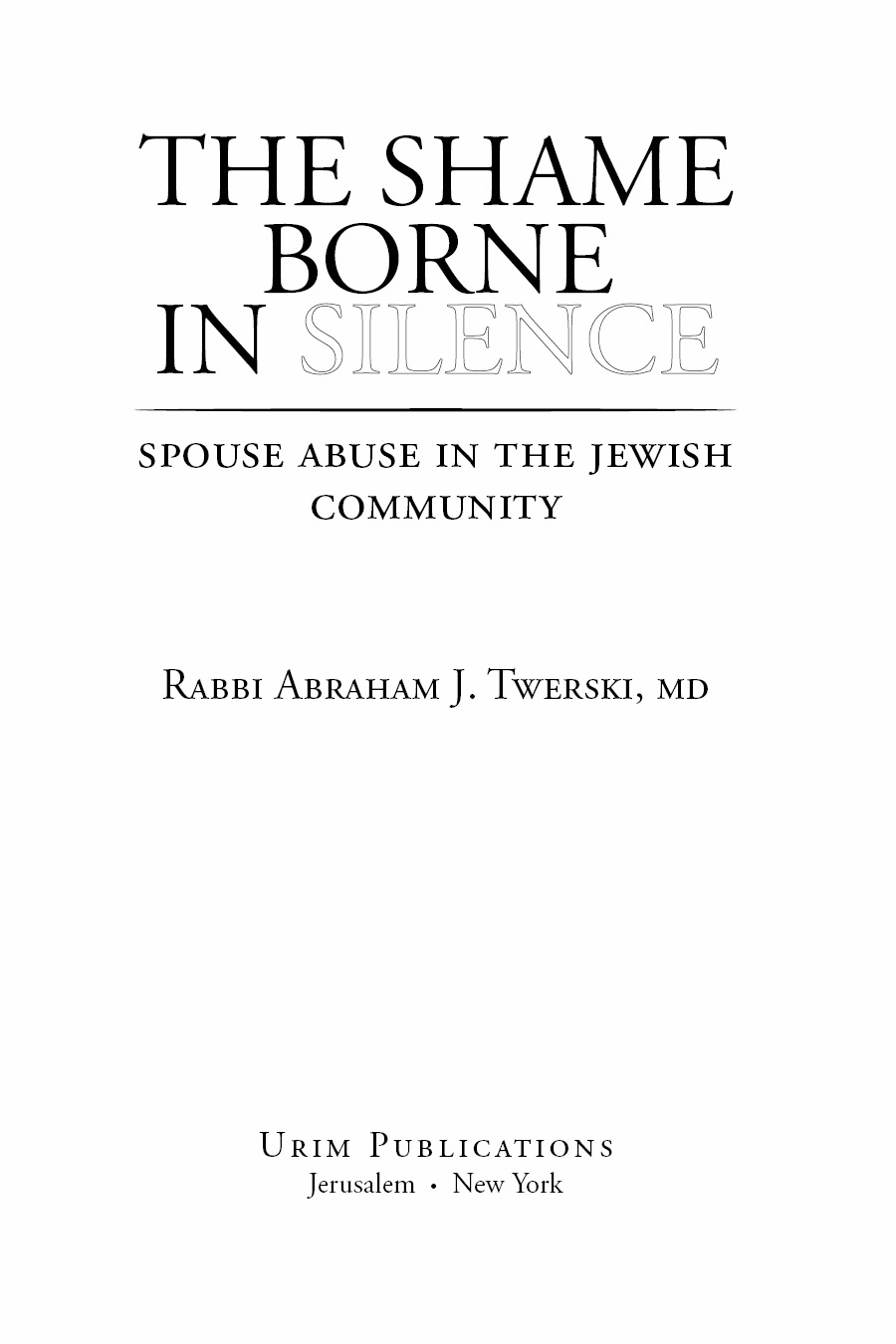The Shame Borne in Silence:
Spouse Abuse in the Jewish Community
by Abraham J. Twerski
Copyright 2017, 2015 Abraham J. Twerski
Revised, Second Edition and with a new preface by the author
First Edition published in 1996 by Mirkov Publications, Inc.
All rights reserved
No part of this book may be used
or reproduced in any manner whatsoever
without written permission from the copyright
owner, except in the case of
brief quotations embodied in
reviews and articles.
Second Edition
ePUB ISBN 978-965-524-292-8
Mobipocket ISBN 978-965-524-293-5
PDF ISBN 978-965-524-294-2
(Softcover ISBN 978-965-524-166-2)
Cover design by the Virtual Paintbrush
Urim Publications
P.O. Box 52287
Jerusalem 9152102 Israel
www.UrimPublications.com
Library of Congress Cataloging-in-Publication Data
Twerski, Abraham J.
The shame borne in silence : spouse abuse in the Jewish community / Rabbi
Abraham J. Twerski. Revised, Second Edition.
pages cm
Includes bibliographical references and index.
ISBN 978-965-524-166-2 (pbk.)
1. Wife abuseReligious aspectsJudaism. 2. Jewish womenAbuse of. 3. Women in Judaism. I. Title.
BM729.W6T94 2014
296.38dc23 20140366
Table of Contents
Chapter
Acknowledgments
I wish to express my sincere appreciation to a number of people whose assistance in preparation of this book was invaluable, by providing either data or constructive editorial comments. They are (alphabetically): Rabbi Moshe Kletenik, Ms. Phyllis Kuhr, MA, Ms. Shirley Lebovics, MSW, Ms. Rachel Pill, MSW, and my daughter, Sarah Twerski, RN.
I also received much assistance and encouragement from personnel and volunteers at various services for domestic violence problems and Jewish Family and Childrens Services. I beg forgiveness if I have omitted people who deserve special mention. My thanks to all of them.
Preface to Second Edition
Y es, times do change.
When I published Th e Shame Borne in Silence in 1996, I aroused the ire of a segment of the observant Jewish community. How dare I intimate that Torah-observant men can be abusive to their wives! For my first few public lectures after publication of the book, I had to have police protection. A number of Jewish bookstores refused to carry the book (Our rabbi said we may not carry it), and those that did, did not have it on display.
There has been progress. My daughter-in-laws book, Im So Confused, Am I Being Abused? is on display in all Jewish bookstores. The problem is discussed more openly.
While there has been progress, there is still a long way to go. Myths die hard. The belief that all Jewish men make ideal husbands, as unrealistic as it is, has not been dethroned. Some rabbis are unaware of the dynamics of spouse abuse and use the make him another kugel approach.
We are grossly lacking in adequate preparation of young men for marriage. The Steipler Gaon said, What do you expect of him? For the past ten years his only relationship has been with his shtender. Shtenders make no demands on a person. One does not have to be considerate of a shtender. This young man is abruptly thrown into the relationship with a person who has needs and wants of her own, some of which may impinge on his comfort and convenience, and does not have the foggiest notion how to deal with this. Young women, too, are lacking in preparation for this new relationship.
Chosson and kallah classes need to be upgraded to teach the basics of marriage relationships. Among some Chassidim, every new couple is assigned a monitor to meet with them regularly during the first year.
The incidence of failed marriages, especially those that disintegrate in the first year, is unprecedented. We need better education on marriage at all levels of the community: the laity, the rabbinate, and the helping services.
Introduction
T his book has been quite difficult for me to write, perhaps because I had to overcome my resistance to acknowledging that the problem of spouse abuse does indeed exist among Jews. We are no doubt influenced by early life experiences, and I can remember nothing in my home other than a husband-wife relationship of mutual caring and utmost respect. The thought that a husband can raise a hand against his wife was totally alien to me.
I was also subject to the widespread cultural belief that wife abuse simply does not exist among Jews, and that in the non-Jewish population, daughters are told to try to get a Jewish husband because Jewish husbands do not drink, gamble, or beat their wives. I remember in my childhood study of Torah that Hagar was an Egyptian princess who could have married into royalty, but sought instead to become a member of the patriarch Abrahams household because of the serenity and blessing that prevailed therein.
As my psychiatric practice progressed, and I began to specialize in the treatment of alcoholism and drug addiction, I was surprised to find that the incidence of such problems among Jews was not negligible and that cases occurred even among traditionally observant families. I also noticed that because of the stigma associated with these problems, Jewish families were most reluctant to seek help because it meant exposing the problem and possibly being stigmatized. But when I saw the tragedy and ruin that resulted from untreated cases of alcoholism and the harm that was being inflicted on young lives because of failure to treat the problem among parents, I could not keep my silence. I wrote articles in the Anglo-Jewish Press and traveled from city to city, addressing Jewish lay audiences, rabbinical associations, and counselors of Jewish social agencies. I also became active in the JACS Organization (Jewish Alcoholics, Chemically Dependent, and Significant Others). I am pleased that these efforts have borne fruit and that the problems of chemical dependency and gambling are being more widely reorganized and treated, saving many lives, marriages, and families.
I responded to my initial awareness of instances of spouse abuse with the same response that so many people had toward that of alcoholism. Sure, there was the town shikker , but he was the exception. The aphorism shikker is a goy , is still valid. And so I wished to believe that the one or two cases of spouse abuse that I encountered were freakish and were merely anomalous occurrences, rare exceptions to the rule that the sacred institution of Jewish marriage is not subject to abuse.
But alas! Calls kept coming in, and in my contact with professional counselors across the country and in Israel, my naivet was shattered. Perhaps the incidence among Jews was not the astronomical number that exists in the non-Jewish population, but neither is it an isolated phenomenon that can be ignored.
A doctor friend of mine told me that he had five hospital admissions for obvious alcohol abuse, and that each time his colleagues had sought to protect him from exposure of his problem because that might have jeopardized his license to practice medicine and earn his livelihood. His untreated alcoholism progressed and resulted in the breakup of his marriage, and it eventually also cost him his hospital privileges. He subsequently wrote an article entitled The Conspiracy of Silence, in which he states that with all their good intentions and kindness, his colleagues allowed him to destroy himself.
I began to be haunted by the concept of Do not stand idly by while your neighbors blood is being spilled (Leviticus 19:16), which the Talmud interprets to mean that one has an obligation to divert harm from coming to another person. When staffs of social agencies told me that their efforts to alert the Jewish community to the problem of spouse abuse were being ignored and that I should address the problem, because with my credentials as a rabbi and psychiatrist I might be better believed, I began to feel uneasy at remaining silent. Someone then pointed out to me that the Talmud says that anyone who has the ability to correct a situation and is derelict in doing so, bears the responsibility for whatever results therefrom ( Shabbos 54b). I realized that I have no option, and that I must speak out.












